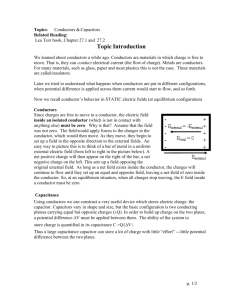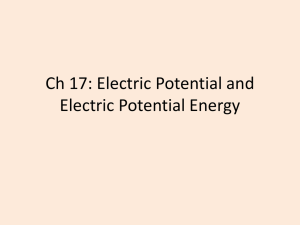Exam1, 1402, Summer II, 2008
advertisement
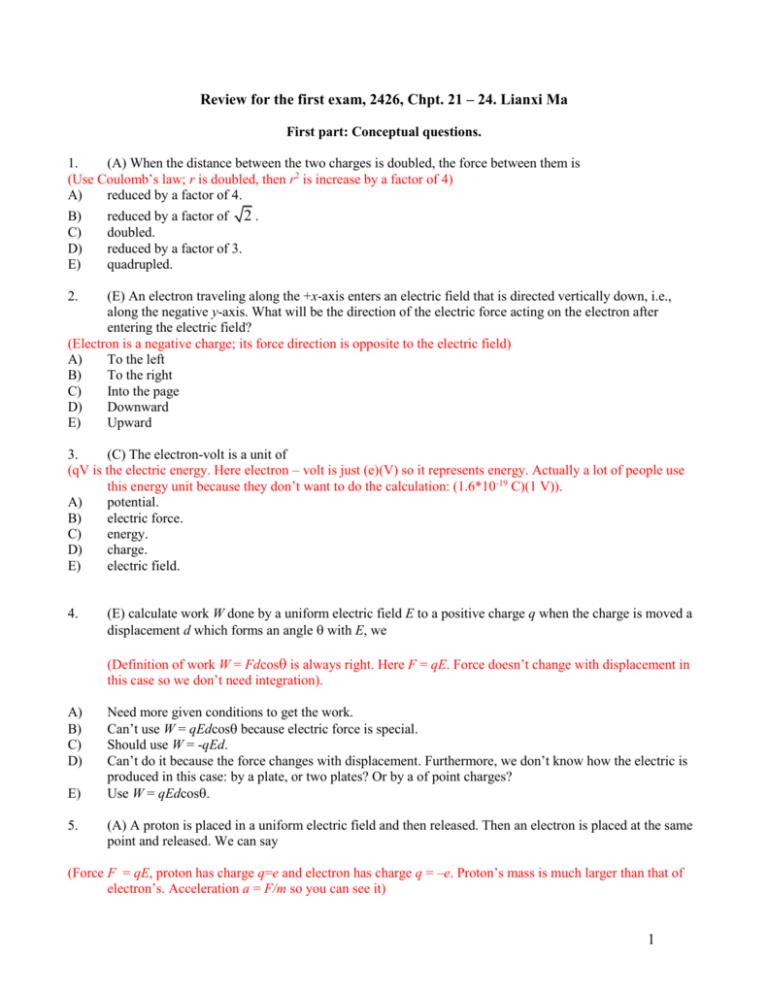
Review for the first exam, 2426, Chpt. 21 – 24. Lianxi Ma First part: Conceptual questions. 1. (A) When the distance between the two charges is doubled, the force between them is (Use Coulomb’s law; r is doubled, then r2 is increase by a factor of 4) A) reduced by a factor of 4. B) C) D) E) reduced by a factor of 2 . doubled. reduced by a factor of 3. quadrupled. 2. (E) An electron traveling along the +x-axis enters an electric field that is directed vertically down, i.e., along the negative y-axis. What will be the direction of the electric force acting on the electron after entering the electric field? (Electron is a negative charge; its force direction is opposite to the electric field) A) To the left B) To the right C) Into the page D) Downward E) Upward 3. (C) The electron-volt is a unit of (qV is the electric energy. Here electron – volt is just (e)(V) so it represents energy. Actually a lot of people use this energy unit because they don’t want to do the calculation: (1.6*10-19 C)(1 V)). A) potential. B) electric force. C) energy. D) charge. E) electric field. 4. (E) calculate work W done by a uniform electric field E to a positive charge q when the charge is moved a displacement d which forms an angle with E, we (Definition of work W = Fdcos is always right. Here F = qE. Force doesn’t change with displacement in this case so we don’t need integration). A) B) C) D) E) 5. Need more given conditions to get the work. Can’t use W = qEdcos because electric force is special. Should use W = -qEd. Can’t do it because the force changes with displacement. Furthermore, we don’t know how the electric is produced in this case: by a plate, or two plates? Or by a of point charges? Use W = qEdcos. (A) A proton is placed in a uniform electric field and then released. Then an electron is placed at the same point and released. We can say (Force F = qE, proton has charge q=e and electron has charge q = –e. Proton’s mass is much larger than that of electron’s. Acceleration a = F/m so you can see it) 1 A) B) C) D) E) They experience the same amount of force. They experience the same amount of acceleration. They will move in the same direction. In both cases the gravity plays an important role in terms of force. Proton is neutral so force on it is zero. 6. (B) For the electric field lines, (They are drawn by people to help us visualize the electric field and they don’t really exist. The density of the lines indicates the strength of the electric field. Both positive and negative charges can produce electric fields that can be described by the electric field lines. Their tangent direction is the force direction on a positive charge, but the lines are not necessarily the trajectory of a charge) A) B) C) D) E) They are the trajectory of the motion of positive charge. They don’t really exist but their tangent direction means the direction of the force on a positive point charge. They really exist but the number of the lines can be arbitrary. The density of the lines is meaningless. Only positive charge can produce the electric field lines. 7. (C) A rubber balloon has a single charge +q in its interior. So the electric flux through the balloon (According to Gauss’s law, = q/0, the flux only depends on the charge q inside the Gaussian surface) A) B) C) D) E) Depends on whether the balloon is fully inflated. Depends on the specific location of the charge although we know it is inside the balloon. Is +q/0 where 0 has its usual meaning. Depends on if there is net charges outside the balloon. Depends on the geometric shape of the balloon. 8. (D) Remember that we derived Gauss’s law in the class by using a sphere with a point charge at its center. When we calculated the electric flux by using EA, the 1/r2 term in the E just cancels r2 term in the A. So we can say that Gauss’s law (The flux = EA in this simple case and the 1/r2 term in the E must cancel r2 term in the A to get Gauss’s law. Otherwise the Gauss’s law is not right) A) B) C) D) E) 9. Is valid even though that the electric field of a point charge were proportional to 1/r3. Is not valid if the sphere becomes oval shaped. Only valid for the metal object but not valid for the insulator. Is only valid when electric field of a point charge is proportional to 1/r2 but would not be valid if the electric field of a point charge were proportional to 1/r3 or any other power. Can be used to calculate electric field produced by any charged objects by choosing appropriate Gaussian surface. (B) About the electric potential (Electric potential is the property of the electric field, has nothing to do with the test charge. Actually this is one of the basic principles to compute the electric potential produced by collection of charges) 2 (A) There are at least two charges to produce the electric potential since V = U/q0, U is the potential energy between them and q0 is the test charge. If q0 is zero then V is zero. (B) If there is only one point charge it will produce electric potential V1 at a certain point; if there are several point charges, the electric potential at a certain point will be V1 + V2 + V3 +… where V1 , V2 , V3 … are potentials produced by q1, q2, q3, … respectively. (C) For a neutral metal at its electrostatic equilibrium its electric potential must be zero because electric field in it is zero. (D) If we know the electric field direction that is from point A to point B, we are still not able to compare VA and VB because the zero potential has not determined yet. (E) For a metal with net charge +Q on its surface at its electrostatic equilibrium, its potential at the surface is higher than that of inside because it is closer to the positive charges. 10. (E) The electric field due to a very large (infinitely large) sheet of charge is (By using Gauss’s law, such problem can be easily solved) (A) kQ/r2, where Q is the total charge on the sheet. (B) Infinity due to the infinite amount of charge. (C) No equation for it since the charge amount is infinite. (D) Weaker at greater distance. (E) Independent of the distance to the sheet since the equation is: /(20), where is surface charge density. (d) You reposition the two plates of a capacitor so that the capacitance doubles. There is vacuum between the plates. If the charges +Q and –Q on the two plates are kept constant in this process, what happens to the potential difference Vab between the two plates? (Use C = Q/V) 11. A. Vab becomes 4 times as great B. Vab becomes twice as great C. Vab remains the same D. Vab becomes 1/2 as great E. Vab becomes 1/4 as great 12. (a) You slide a slab of dielectric between the plates of a parallel-plate capacitor. As you do this, the potential difference between the plates remains constant. What effect does adding the dielectric have on the amount of charge on each of the capacitor plates? (Q = CV, C is increased, so is Q) a. b. c. d. The amount of charge increases. The amount of charge remains the same. The amount of charge decreases. not enough information given to decide Part II. Quantitative Problems. 1. (E) Find the net charge of a system consisting of 3.9 × 107 electrons. (3.9 × 107 electrons * 1.6 × 10-19 Coulomb/electron = ? and electrons are negative) A) 3.9 × 10-7 C 3 B) C) D) E) -3.9 × 10-7 C -8.6 × 10-10 C 5.4 × 10-15 C -6.2 × 10-12 C (C) Two point charges lie on the x axis. A charge of +6.2 μC is at the origin, and a charge of -9.5 μC is at x = 10.0 cm. What is the net electric field at x = -4.0 cm? (draw a diagram please and use E = kq/r2 to find E1 and E2, add them, pay attention to their directions) A) 4.5 × 107 N/C x̂ B) -3.9 × 107 N/C x̂ C) -3.0 × 107 N/C x̂ D) 2.7 × 107 N/C x̂ E) -1.2 × 107 N/C x̂ 2. (A) Consider a spherical Gaussian surface and three charges: q1 = 1.65 μC, q2 = -2.32 μC, and q3 = 3.71 μC. Find the electric flux through the Gaussian surface if it completely encloses only charges q1 and q2. (Gauss’s law = q/0, q is total charge inside the Gaussian surface) a. -7.60×104 N m2/C b. -2.32×104 N m2/C c. -3.71×104 N m2/C d. 1.65×104 N m2/C e. 5.21×104 N m2/C 3. 4. (B) The electrons in a TV picture tube are accelerated from rest through a potential difference of 25 kV. What is the speed of the electrons after they have been accelerated by this potential difference? (Use energy conservation: Ei = Ef, then you get familiar equation for vf.) A) 7.3×107 m/s B) 9.4×107 m/s C) 2.0×107 m/s D) 6.5×107 m/s E) 3.0×108 m/s (B) How far must the point charges q1 = +7.22 μC and q2 = -26.1 μC be separated for the electric potential energy of the system to be -126 J? (Electric potential energy for point charges: u = k q1q2/r ) A) 0.232 cm B) 1.34 cm C) 3.42 cm D) 4.55 cm E) 5.32 cm 5. 6. (d) A 12–F capacitor and a 6–F capacitor are connected together in series. What is the equivalent capacitance of the two capacitors as a unit? (In series? You know how to do it) A. Ceq = 18 F B. Ceq = 9 F C. Ceq = 6 F D. Ceq = 4 F E. Ceq = 2 F 4 7. (c) A 12–F capacitor and a 6–F capacitor are connected together in series. If the charge on the 12– F capacitor is 24 C, what is the charge on the 6–F capacitor? (In series? Each capacitor has same amount of charge) A) 48 C B) 36 C C) 24 C D) 12 C E) 6 C 8. (d) You reposition the two plates of a capacitor so that the capacitance doubles. There is vacuum between the plates. If the charges +Q and –Q on the two plates are kept constant in this process, the energy stored in the capacitor (U = Q2/(2C), so…) B) becomes 4 times greater. C) becomes twice as great. D) remains the same. E) becomes 1/2 as great. F) becomes 1/4 as great. Part III, Free response problems. 1. q = 12 nC and q = -24 nC. Distance between them is 0.10 m. Compute the electric field at point c. 1 2 E 7.37 103 iˆ 5.90 103 ˆj ( N / C ) 2. A ring with radius a = 20 cm and total charge Q = 2.0 C uniformly distributed around it. (a) Find the E at point P where x = 3.0 m. (b) Find the potential at point P if take V = 0 when r . 5 (a) 2.0×109 N/C, x direction; (b) 6.0×109 V. 3. A solid conductor with a cavity carries charge of 7 nC. Point charge inside is of -5 nC. (A) How much charge is on each surface? (B) Suppose the conductor is a spherical shell, can you find the electric field in all the space? (A) inner surface: +5 nC; outer surface: +2 nC. (B) r<R1: E1 = 45/r2, inward direction. R1<r<R2: E2 = 0. r>R2: E3 = 18/r2, outward direction. 4. Find the potential at a distance r>R from a very long metal cylinder of radius R of charge with linear charge density . Find the speed of a proton if it is released at r1 and when it reaches the r2. r>R: V1-V2 = 2kln(r2/r1) ; v = [4ekln(r2/r1)/m]1/2 5. A spherical capacitor is formed from two concentric spherical conducting shells separated by vacuum. The inner sphere has a radius of ra = 12.3 cm, and the outer sphere has a radius of rb = 15.1 cm. A potential difference of 120 V is applied to the capacitor. (a) What is the capacitance of the capacitor? (b) What is the magnitude of the electric field at radius of 12.8 cm, just outside the inner sphere? (c) What is the magnitude of electric field at 14.6 cm, just inside the outer sphere? (a. 7.3810-11 F; b. 4860 V/m; c. 3730 V/m). 6

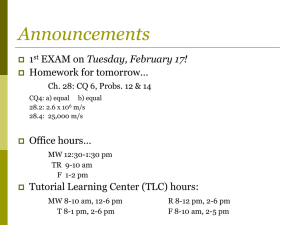
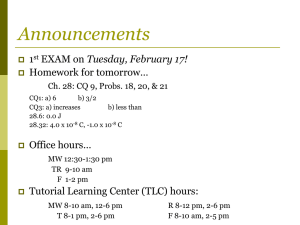
![Sample_hold[1]](http://s2.studylib.net/store/data/005360237_1-66a09447be9ffd6ace4f3f67c2fef5c7-300x300.png)
